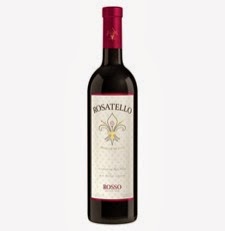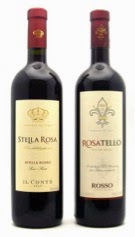Stella Rosa Trumpets Pyrrhic Trade Dress “Victory” Over Constellation
Plaintiff San Antonio Winery, Inc. (“SAW”) filed suit against Constellation Brands last August in the Central District of California, alleging trademark infringement, false designation of origin, and unfair competition due to Constellation’s promotion and sale of fizzy, low-alcohol, sweet (“FLAS”) red wine under the mark ROSATELLO.
SAW claims trademark rights in the mark STELLA ROSA and its “Stella Rosa Crown” design mark (U.S. Trademark Reg. Nos. 4,000,471 and 3,663,013, respectively) and use of the mark allegedly going back to 2004. In October 2013, subsequent to SAW’s filing, Constellation changed the design of its “Rosatello” labels, but otherwise kept the name in use.
Then in November, SAW filed a motion for preliminary injunction to prevent sales of ROSATELLO in connection with FLAS wine, which was heard by the court in late January. The court’s orders came down on March 11, 2013 – one order denying the injunction with respect to Constellation’s use of the trademark ROSATELLO on its newly modified packaging, and another order granting an injunction – but only as it relates to Constellation’s prior packaging, which is no longer in use.
THROWING THE MUD
In its moving papers, SAW claimed that Constellation copied its product line, transposed the STELLA ROSA trademark, and copied the packaging in a bad-faith scheme to “steal” its market share, resulting in actual confusion to consumers and retailers. Evidence of confusion consisted of Instagram posts, as well as statements from a wine store owner, a manager and wine purchaser personnel. SAW also cited in-store displays allegedly showing Rosatello product stocked on shelf space marked for Stella Rosa, and Stella Rosa product displayed atop a case of Rosatello.
SAW alleged that Constellation’s marketing confused retailers into believing that Stella Rosa had become one of the Constellation brands, damaging its image as a 100-year-old family-owned winery operation.
SAW provided “line-up” survey evidence which allegedly shows that 52% of respondents showed some confusion (over 50% confusion is considered “persuasive evidence”), based in part upon similarities in font, the crown logo adorning the capsule, the bottle shape and label design (including the word “Rosa” in red type with a similarly stylized “R”).
WHAT DO YOU MEAN: NO TRADEMARK INFRINGEMENT?
To obtain a preliminary injunction is usually a tall order. In this case, while the discontinued packaging was found problematic, the ROSATELLO trademark was not enough, by itself, to warrant an injunction from the court.
The court noted several key points in its denial of the trademark injunction. For example, when SAW applied to register the STELLA ROSA mark, it was refused on the basis of prior registrations for STELLA BELLA and BUONA STELLA, and SAW overcame such refusals by arguing that its mark was distinctly different from those other marks, as well as the mark STELLA, and hence unlikely to cause confusion. (Yes, what you say to the USPTO can and eventually will be used against you. –ed.)
In its motion, SAW relied on its considerable advertising expenditures (approximately $3.5 million) and commercial success (sales over $100 million in the last decade) of Stella Rosa to demonstrate how the strength of its mark increased over time, from what was originally considered a weak mark at the time of registration.
While the court found similarities with STELLA ROSA in the color scheme, label location and font of the prior ROSATELLO packaging, the new packaging was found to differ in all of those respects. Interestingly, despite survey evidence which showed that 37.6% of the respondents mentioned something about the name being similar, the court found that this did not support the position that the names STELLA ROSA and ROSATELLO are similar to one another, or that use of the names alone will independently confuse consumers, since the names did not appear in isolation from the packaging in SAW’s survey. (This is an important lesson in survey methodology.) The court noted that, while they bear some auditory resemblance to one another, the two marks begin and end with different sounds, and do not share any meaning – and that SAW provided no evidence that the current versions of the respective products are similar enough to confuse consumers.
The survey evidence and accounts from both retailers and consumers were found by the court to be unsupportive of the likelihood of confusion, since Constellation had already discontinued use of its prior ROSATELLO label.
SPIN CITY: WHAT’S REALLY GOING ON HERE?
Some wine writers — and even SAW’s own legal counsel in the matter — would have you believe that this represents a key victory for SAW over the “global giant” Constellation, but in reality this is hardly the case. The press release by SAW’s counsel states: “[T]he court entered an order on March 11th preliminarily enjoining Constellation’s use of the complained-of labels,” (emphasis added) but only the prior label was enjoined. In reality, the injunction is strictly limited to the older ROSATELLO product label, and only in connection with FLAS wine – Constellation’s use of ROSATELLO in connection with sparkling wines and other offerings has not been challenged by SAW’s suit.
In fact, Constellation’s ROSATELLO has not perceptibly skipped a beat, as sales continue under a slightly modified label and trade dress. Perhaps more importantly, this ruling by the court is potentially somewhat of a setback in SAW’s overall enforcement of the trademark STELLA ROSA, for which the injunction was clearly denied — creating an uphill battle for SAW on the trademark infringement claim, and effectively establishing the rather narrow scope of legal protection likely to be afforded to the STELLA ROSA mark going forward.
Below is a side-by-side comparison of the STELLA ROSA alongside both the old and new ROSATELLO bottles. Are consumers really likely to be confused?
For trademark protection and enforcement inquiries, please contact Chris Passarelli, Senior Intellectual Property Counsel at Dickenson, Peatman & Fogarty, at: [email protected].



